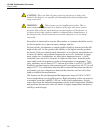
6 Operation
6.1 Overview
The Model 9112A is basically a temperature controlled furnace utilizing a full
PID micro-processor based temperature controller with a Type K thermocouple
temperature sensor. The temperature controller sends a time proportional signal
to the solid state relay which regulates the current to the heater. The heater
power can be switched to HIGH or LOW power positions. The object of the
temperature control is the equilibration block with test wells containing the ref
-
erence probe and the sensors to be calibrated inside. The block provides a ther
-
mal mass which tends to stabilize the temperature and reduce the gradients
between the test wells. The user settable “over-temperature cut-out” can open
the heater circuit with a relay if the safe temperature for the test probe or for
the furnace is exceeded. The enclosure is designed to limit the heat seen by the
various components of the furnace as well as the user. The control section is in
a separate cabinet below the furnace heat preventing damage or accuracy er
-
rors. The furnace part of the cabinet contains ventilation holes as well as two
fans controlled by the thermostat. This cooling capability prevents the surface
of the enclosure from getting dangerously hot. In the event that the fans should
fail, a second thermostat is installed in the cabinet which shuts down the fur-
nace heaters if the cabinet exceeds a safe temperature.
6.2 Operating the Furnace
Operating the Model 9112A is straight forward once you have grasped all the
important principles.
When the unit is turned on, the cutout reset button must be pushed before the
unit will heat.
Temperature selection is accomplished by using the up and down arrow keys on
the front of the temperature controller. The lower display indicates the new
temperature setting while the upper display shows the actual temperature.
When scanning from one temperature to another, notice that the temperature
controller seems to be ahead of the equilibration block temperature. This differ
-
ence is because the temperature control sensor is near the outside of the block
and it takes some time for the heat to conduct into the center. Depend on an ex
-
ternal temperature monitor to establish when the equilibration block has
reached the desired temperature and achieved stability.
The actual temperature indication made by the temperature controller is not in
-
tended to be a calibration reference, but to merely provide a general indication
of the furnace temperature. NIST traceable standard thermometers are available
and should be used in making comparison measurements. For less stringent
measurements you may make a calibration of the controller and control probe
at particular temperature points and use that with reasonable accuracy for a
time.
23
6 Operation
Overview


















